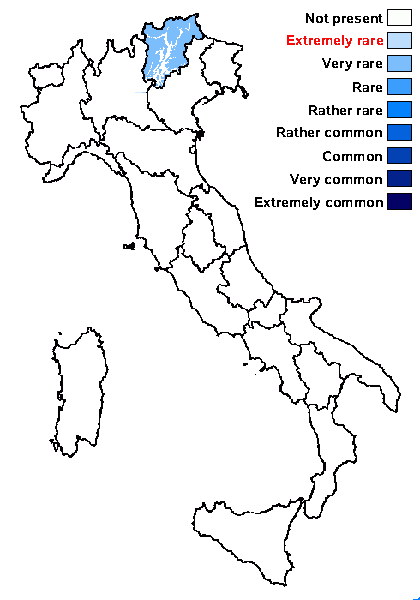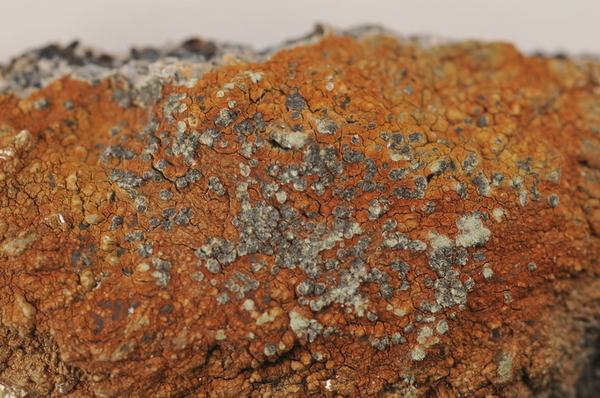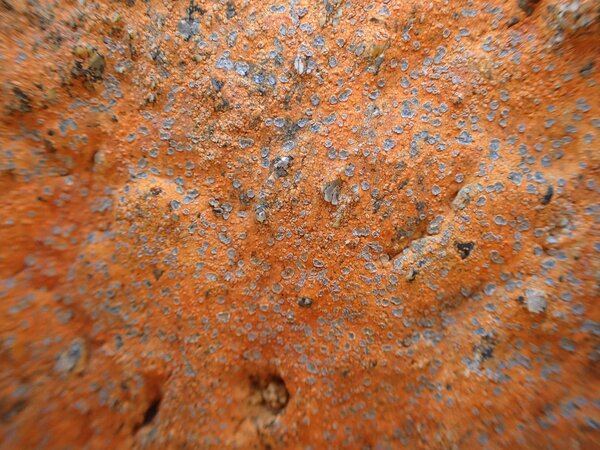Porpidia melinodes (Körb.) Gowan & Ahti
Ann. Bot. Fenn., 30: 67, 1993. Basionym: Aspicilia melinodes Körb. - Sber. Akad. Wiss. Wien, Math.-naturw. Kl., Abt. 1, 71: 3, 1872.
Synonyms: Haplocarpon melinodes (Körb.) V. Wirth; Huilia melinodes (Körb.) Hertel; Lecidea melinodes (Körb.) H. Magn.
Distribution: N - TAA (UPS-L-166873).
Description: Thallus crustose, episubstratic, orange to orange-grey, sometimes with olivaceous patches, smooth to cracked-areolate, sorediate, delimited by a byssoid, dull grey to black prothallus, the areoles angular, divided by deep cracks, smooth. Soralia scattered or in groups of 2-4, whitish but often with dark grey specks, 0.2-0.6(-1) mm across, crater-like and often delimited by a whitish, raised thalline rim, the soredia coarsely granular. Medulla white, I-. Apothecia very rare, lecideine, black, at first semi-immersed, then sessile with a broad base, 0.3-1.5(-3) mm across, with a mostly flat, finally convex, thinly to heavily pruinose, sometimes subgyrose disc, and a thick, raised, smooth to crenulate, often finally flexuous and epruinose proper margin. Proper exciple of conglutinated, branched, 2-4 μm thick hyphae radiating from the hypothecium, dark in outer part, paler within; epithecium olive-brown, granulose; hymenium colourless, 75-120(-150) μm high; paraphyses coherent, branched and anastomosing, slightly swollen at tips; hypothecium colourless or pale yellow-brown in upper part, dark brown in lower part. Asci 8-spored, elongate-clavate, with a thin, outer amyloid layer and a thickened tholus penetrated by a pore, the sides of which are strongly amyloid, Porpidia-type. Ascospores 1-celled, hyaline, ellipsoid, halonate, (14-)18-23(-26) x (6.5-)8-11 μm. Photobiont chlorococcoid. Spot tests: soralia/medulla K- or (rarely) K+ pale yellow, C-, KC-, P- or (rarely) P+ pale yellow-orange; medulla K/UV+ mauve. Chemistry: thallus with confluentic acid (major), 2’-0-methylperlatolic and 2’-0-methylmicrophyllinic acids, rarely with additional stictic, norstictic and cryptostictic acids.
Note: on horizontal to moderately inclined surfaces of siliceous, often metal-rich rocks lying on or near the ground in scree fields, mostly in upland areas; for a long time treated as a sorediate morph of P. flavicunda; some records are likely hidden among those of that species.
Growth form: Crustose
Substrata: rocks
Photobiont: green algae other than Trentepohlia
Reproductive strategy: mainly asexual, by soredia, or soredia-like structures (e.g. blastidia)
Species of metal-rich rocks
Commonnes-rarity: (info)
Alpine belt: very rare
Subalpine belt: very rare
Oromediterranean belt: absent
Montane belt: very rare
Submediterranean belt: absent
Padanian area: absent
Humid submediterranean belt: absent
Humid mediterranean belt: absent
Dry mediterranean belt: absent

Predictive model
Growth form: Crustose
Substrata: rocks
Photobiont: green algae other than Trentepohlia
Reproductive strategy: mainly asexual, by soredia, or soredia-like structures (e.g. blastidia)
Species of metal-rich rocks
Commonnes-rarity: (info)
Alpine belt: very rare
Subalpine belt: very rare
Oromediterranean belt: absent
Montane belt: very rare
Submediterranean belt: absent
Padanian area: absent
Humid submediterranean belt: absent
Humid mediterranean belt: absent
Dry mediterranean belt: absent

Predictive model
 INDEX FUNGORUM
INDEX FUNGORUM
 GBIF
GBIF
 DOLICHENS
DOLICHENS




